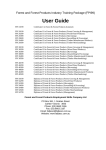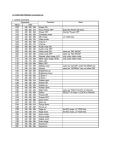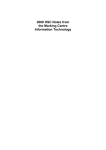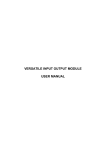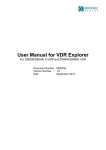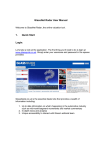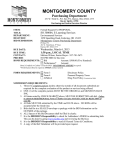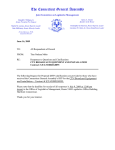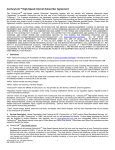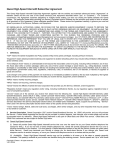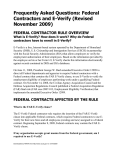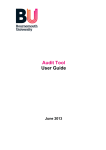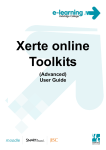Download Retail - Board of Studies Teaching and Educational Standards NSW
Transcript
Retail Curriculum Framework Stage 6 Support Document 2000 Acknowledgement Material from the Retail Training Package is Australian National Training Authority (ANTA). Reproduced with permission The following copyright warning applies to the material from the Training Package: All rights reserved. This work has been produced initially with the assistance of funding provided by the Commonwealth Government through ANTA. This work is copyright, but permission is given to trainers and teachers to make copies by photocopying or other duplicating processes for use with their own training organisations or in a workplace where the training is being conducted. This permission does not extend to the making of copies for use outside the immediate training environment for which they are made, nor the making of copies for hire or resale to third parties. The views expressed in this version of the work do not necessarily represent the views of ANTA. ANTA does not give warranty nor accept any liability. The Board of Studies owns the copyright on all syllabus support documents. Schools and colleges may reproduce this syllabus support document in part or in full for bona fide study or classroom purposes only. Acknowledgement of the Board of Studies copyright must be included on any reproductions. Students may copy reasonable portions of the syllabus support document for the purpose of research or study. Any other use of this syllabus support document must be referred to the Copyright Officer. The Board of Studies has made all reasonable attempts to locate owners of third party copyright material and invites anyone from whom permission has not been sought to contact the Copyright Officer, Board of Studies NSW, 117 Clarence St, Sydney NSW 2000, Tel (02) 9367 8111; fax (02) 9279 1482. © Board of Studies NSW 2000 Published by Board of Studies NSW GPO Box 5300 Sydney NSW 2001 Australia Tel: (02) 9367 8111 Internet: http://www.boardofstudies.nsw.edu.au ISBN 0 7313 4477 4 2000132 Retail Curriculum Framework Stage 6 Support Document Contents 1 Introduction .......................................................................................................................... 4 2. Teaching Programs .............................................................................................................. 5 2.1 General Information..................................................................................................... 5 2.2 Sequence of Delivery .................................................................................................. 6 2.3 Integrated Approaches to Programming - Using Themes, Projects and Events............. 7 2.4 Programming Individual Units of Competency.............................................................. 7 3 Assessment ......................................................................................................................... 9 3.1 HSC Vet Frameworks - The Purposes of Assessment ................................................. 9 3.2 Assessment for the AQF.............................................................................................. 9 3.2.1 Assessment Strategy ............................................................................................ 9 3.2.2 Integrated Competency Assessment ................................................................... 10 3.2.3 Evidence for Assessment.................................................................................... 11 3.2.4 Principles of Assessment .................................................................................... 11 3.2.5 Guides to Assessment Activities ......................................................................... 13 3.2.6 Programming Assessment .................................................................................. 13 3.3 The HSC Examination ............................................................................................... 13 3.3.1 Internal Examinations ......................................................................................... 13 3.4 Recording Assessment.............................................................................................. 13 3.4.1 Competency Record - Sample Unit of Competency Record Sheet....................... 14 3.4.2 Competency Record -Sample Record of Integrated Competency Assessment..... 15 3.5 Sample Assessment Events ...................................................................................... 16 3.5.1 Sample Integrated Competency Assessment Event for Phase A ......................... 16 3.5.2 Sample Integrated Competency Assessment Event for Phase B ......................... 19 3.5.3 Sample Integrated Competency Assessment Event for Phase C1 ....................... 21 3.5.4 Sample Unit Assessment - WRRCS1 Communicate in the workplace.................. 24 3.5.5 Sample Unit Assessment - WRRLP.1A Apply Safe Work Practices ..................... 29 3.5.6 Sample Unit Assessment - WRRCA.1 Operate Retail Equipment ........................ 31 4 Work Placement ................................................................................................................. 33 4.1 Principles Underpinning Work Placement in the Higher School Certificate.................. 33 Retail Curriculum Framework Stage 6 Support Document 1 Introduction The Retail Curriculum Framework has been developed to provide students with the opportunity to gain credit towards the NSW Higher School Certificate and credit towards national vocational qualifications in Retail under the Australian Qualifications Framework. The framework is based on the national Retail Training Package (WWR97). This industry curriculum framework incorporates all Higher School Certificate Retail VET courses whether: • delivered by schools • delivered by TAFE colleges or • delivered by other Registered Training Organisations on behalf of schools or TAFE colleges This document, the Support Document for the Retail Curriculum Framework Stage 6 Syllabus (Board of Studies, NSW, 1999) contains materials and advice which is intended to assist teachers and trainers in the implementation of courses within the framework and the assessment of student competency. It must be read in conjunction with Parts A and B of the syllabus. Part A of the syllabus contains general advice about the Retail Curriculum Framework and describes course structures and requirements, including work placement. The use of part A is mandatory in the delivery of all HSC courses in Retail. Part B of the syllabus contains the text of the units of competency from the Retail Training Package that comprise the AQF Certificate II in Retail Operations, Phases A, B and C1. Part B must be used in the delivery of 120 and 240 indicative hour HSC courses in Retail and of the Retail Operations – General Selling extension course. (Note that the units of competency for Phases C2 and C3 should be accessed directly from the Retail Training Package). The documentation for the Retail Curriculum Framework also includes a competency record for recording assessment activities and student achievement of competency. The use of the competency record is recommended but is not mandatory. RTOs may choose to design an alternative form of competency record or to use the Learner Record Book that is part of the support materials for the Retail Training Package. Industry Curriculum Framework Documentation Syllabus Part A Course Structures and Requirements Syllabus Part B Units of Competency and HSC Requirements Competency Record Support Document Resource List Support materials for this curriculum framework include this support document and a resource list. The Board has also developed the Stage 6 Industry Curriculum Frameworks Support Document for Students with Special Education Needs. Parts A and B of the syllabus are available in hard copy from the Board of Studies and may also be accessed on the Board’s website (http://www.boardofstudies.nsw.edu.au) The Competency Record, the support documents and the resource list may be accessed through the website. 4 Retail Curriculum Framework Stage 6 Support Document 2. Teaching Programs 2.1 General Information Teaching/training programs for courses in the Retail Curriculum Framework can be developed using a number of different approaches. These include: • programming individual units of competency sequentially • identifying a theme which is common to several units of competency and programming teaching and learning activities which address this theme • devising a project, experience or event which requires students to learn and use a number of competencies • a combination of any of the above. Each approach has merit depending on the nature of particular competencies, access to facilities, equipment, resources and work placements, and the needs and experience of the student group and individual students. When considering these approaches, teachers and trainers should keep in mind the following general principles. • • • • VET courses focus on the achievement of workplace competence. They are intended to equip students with the skills and knowledge required to perform workplace roles to the standard expected in industry. Competence incorporates all aspects of work performance including communication, problem solving and the capacity to apply skills and knowledge in both familiar and new situations as well as industry specific skills. Students must be given the opportunity to develop skills over time and have multiple opportunities to demonstrate that they possess the necessary combination of skills and knowledge. Students must have the opportunity to develop and practise skills in a workplace setting. Assessment of competence involves the assessment of skills and knowledge combined. An integrated or holistic approach to assessment is required in line with the concept of competence as the integration of a wide range of skills, knowledge and attitudes. An integrated approach to course delivery will facilitate integrated competency assessment. On the basis of these principles, it is recommended that teachers and trainers develop teaching and learning programs that allow for the integrated development of several elements and/or units of competency simultaneously. Where this is not possible, learning activities developed for individual units of competency should seek to integrate elements within the unit and to address the linkages to other units identified in the training package and in the syllabus. Where possible, assessment strategies should be included as an integral part of training. 5 Retail Curriculum Framework Stage 6 Support Document 2.2 Sequence of Delivery The Retail Training Package groups the units of competency in Certificate II in Retail Operations into three phases, each related to a general theme. Students undertaking Retail Operations (120 indicative hours) must attempt all units in Phase A. Students undertaking Retail Operations (240 indicative hours) must attempt all units in Phases A and B and unit WRRS.1A from Phase C1/C2. Students undertaking Retail Operations extension courses must, in addition, attempt the appropriate units from Phase C1 or Phase C2 or Phase C3. Refer to the Retail Curriculum Framework Stage 6 Syllabus, Part A for details of course structures. Neither the Retail Curriculum Framework nor the Retail Training Package prescribes that the delivery sequence for individual units of competency or for related groups of units of competency must correspond to these phases. However, the phases are designed to allow students to build on competencies developed and they are mandatory in designing and conducting integrated competency assessment events for AQF qualifications. Thus, while teachers should use professional judgement based on the existing skills and experience of students, student interest, access to facilities including workplaces and the timing of work placement in sequencing a teaching program, the following points should be kept in mind. • • • students will not be eligible for AQF qualifications unless they have successfully undertaken integrated competency assessment as required by the Retail Training Package for each of the relevant phases. ie − for Certificate II in Retail Operations - Phase A and Phase B and either Phase C1 or Phase C2 or Phase C3 − for Certificate I in Retail Operations - Phase A students exiting Retail Operations (240 hours) after 120 hours will only be eligible for the AQF Certificate I if they have undertaken all units in Phase A and have successfully completed integrated competency assessment for Phase A. competencies within a particular phase relate to a unifying theme and facilitate a thematic, integrated approach to delivery as well as to assessment In addition • competencies within a particular stream often build upon each other eg WRRCS.2A Interact with Customers builds on competencies developed in WRRCS.1A Communicate in the Workplace. These links are identified in the Retail Training Package and Part B of the syllabus. • some units are introductory whereas others clearly depend on existing skills • aspects of some units eg WRRLP 1A Apply safe work practices are best addressed before students undertake work placement • other units will only be meaningful once a student has experienced a real workplace environment. 6 Retail Curriculum Framework Stage 6 Support Document 2.3 Integrated Approaches to Programming - Using Themes, Projects and Events The structure and assessment requirements of the Certificate II in Retail Operations facilitate a thematic approach to training delivery. However, the themes identified in the training package each relate to a number of units of competency. In constructing a program you may wish to identify more specific themes which relate to fewer units and elements. This could involve “unpacking” the theme for the relevant phase or identifying another theme that runs through several units and or elements. The use of projects, experiences and events allows for the concurrent development and assessment of a number of units and elements of competency. They may be used for the full delivery of particular competencies or to supplement other learning and assessment activities. Events may refer to real or simulated workplace events (eg a sale, a stocktake). Projects may be designed to be completed in the student’s workplace. The following steps may provide a guide to planning and organising integrated approaches to delivery. Step 1 Based on your knowledge of the course you intend to deliver, the interests and experience of your students and available resources, devise a project, event or theme that relates to a number of competencies. Step 2 Using Part B of the syllabus, map components/activities/deliverables of the project to particular units/elements ensuring that there is opportunity for students to develop competency and demonstrate the performance criteria for each element included. Where necessary, modify the project specifications to address elements/performance criteria. Step 3 Using the information from Step 2, list the elements of competency and identify appropriate assessment strategies. Plan to use a range of assessment instruments over time to validate the evidence collected. Also try to use each assessment opportunity to assess and record evidence of competence for a number of elements. In this way overassessment can be avoided. (Remember that assessment practices must conform to the Method and Context of Assessment described within each unit of competency and to the Assessment Guidelines of the Retail Training Package.) Step 4 Draw up a programming sheet to summarise this information. You may or may not wish to define learning outcomes for components of the project or include a schedule. The template on the next page is provided as an exemplar. 2.4 Programming Individual Units of Competency When programming individual units of competency • ensure that all elements of competency are addressed • ensure that HSC Requirements are addressed • stress links with other units • adopt an integrated assessment approach Learning activities for individual units of competency are contained in the Learner’s Guides that form part of support materials for Retail Training Package. These should be supplemented from other sources. 7 Retail Curriculum Framework Stage 6 Support Document Project/Theme: Timing Learning outcomes Units/Elements of Competency Project Specifications Teaching Strategies/Learning Experiences 8 Possible Assessment Strategies Retail Curriculum Framework Stage 6 Support Document 3 Assessment 3.1 HSC Vet Frameworks - The Purposes of Assessment Assessment for the Higher School Certificate VET Framework has two distinct purposes. a) Assessment for the Australian Qualification Framework (AQF) - Competency based: • Applies to all courses within frameworks. • Vehicle for industry recognition. b) Assessment for the University Admissions Index (UAI): • Optional for the 240 hour course only. • Written HSC examination. 3.2 Assessment for the AQF Assessment for the purpose of obtaining qualifications under the Australian Qualifications Framework • is competency based. • must be reliable, flexible, fair and valid. Judgements are made on the basis of evidence, which may be in a variety of forms. • must be conducted by qualified assessors as defined in the Retail Training Package and be consistent with the Method and Context of Assessment described in each unit of competency and with the Retail Training Package Assessment Guidelines. • assesses students as competent or not yet competent. To obtain AQF qualifications in Retail, students must successfully complete integrated competency assessment as specified in the Retail Training Package for the relevant Phases of Certificate II. An integrated or holistic approach to AQF assessment tasks is required. 3.2.1 Assessment Strategy This section is reproduced from Section 3 Guidelines for Designing Assessment Materials of the Assessment Guidelines of the Retail Training Package Assessment conforms with the principles of the Australian Recognition Framework and is in accordance with the NRTP-WRR97 Assessment Guidelines. Assessment is both training organisation and workplace based. The most appropriate method of assessing workplace competency is through demonstration and observation in the workplace, under normal working conditions and with the assistance from tools, equipment, job aids and work colleagues that would normally be available on the job. The following general principles and strategies apply: • • assessment is competency based assessment is criterion-referenced Within each certificate, the units of competency are grouped into phases of units which are interrelated, to facilitate the assessment process. 9 Retail Curriculum Framework Stage 6 Support Document Each unit within a phase has a series of assessment criteria within and on completion of the units and these are specified in the Performance Criteria and Evidence Guides in the standards. These criteria are designed to check the candidates’ progress and measure their performance. When assessing performance for a certificate, the assessment activities within and/or on completion of each unit will generally be carried out by the workplace coach/trainer, workplace assessor, or the off job trainer, depending on the learning situation. Formal assessment for the certificates in the NRTP-WRR97 is based on the Integrated Competency Assessment activities which must be carried out by qualified assessors. 3.2.2 Integrated Competency Assessment This section is reproduced from Section 3 Guidelines for Designing Assessment Materials of the Assessment Guidelines of the Retail Training Package Integrated Competency Assessment activities integrate the workplace competencies into a holistic activity for a phase of interrelated units of competency. When Statements of Attainment only are being sought for individual units, the integrated assessment activity (Unit Assessment) must be based on an integration of the performance criteria into a holistic activity for that unit. In either strategy, the Integrated Competency Assessment activities will require the candidates to: • use the appropriate key competencies • apply the skills and knowledge which underpin the process required to demonstrate competency in the workplace. Integrated Competency Assessments are the key assessment activities to assess the units of competency covered by the related units within a phase. These Integrated Competency Assessments are designed to focus the candidates and the assessor on using key competencies and developing transferable skills through the demonstration of competence across all competency units within a phase. It is possible for a candidate to seek assessment for a phase through completing the Integrated Competency Assessment without completing all the assessment activities for the units. In these situations recognition of current competency is being sought for specific units. It will be the responsibility of the assessor to ensure that integrated assessment is of sufficient rigour to provide adequate evidence of competence in the areas not covered by unit assessment. All candidates are bound to provide three pieces of evidence required by the NRTP-WRR97 Assessment Guidelines policy and selected from the range specified in Section 3.3 of the Assessment Guidelines. (Reproduced as section 3.2.3 below) The Integrated Competency Assessment approach is low cost, takes account of the skills of both candidates and assessors, involves the use of evidence gathering methods appropriate to the context and is open to being contextualised for particular situations and industry sectors. The assessment method encompasses recognition of current competencies which may also involve the use of self assessment processes. 10 Retail Curriculum Framework Stage 6 Support Document 3.2.3 Evidence for Assessment This section is reproduced from Section 3 Guidelines for Designing Assessment Materials of the Assessment Guidelines of the Retail Training Package. “Competence” cannot be seen. We only know that competence exists because of the outcome. Therefore competency based assessment is a process of collecting evidence of competence. that evidence may be directly observed, or written, or provided by others. Multiple sources of evidence will be available to ensure flexibility, and used as appropriate. The Evidence Guides from the National Retail Competency Standards will be the basis of the assessment tools to be used. They should be contextualised to suit the workplace. Evidence must be gathered from the following range of sources, including: • Direct • • • • Indirect • evaluation of the finished product or outcome of the performance • video taped performance • presentation • projects, written assignments • historical evidence, third party report • Supplementary • questioning, interviews • portfolio/log book observation of workplace performance demonstration of practical skills role plays, simulation Arrangements for assistance for small business need to be further considered. Historical evidence should be accepted if validated, for example, when the candidate has successfully performed the work over a number of years. 3.2.4 Principles of Assessment This section is reproduced from Section 3 Guidelines for Designing Assessment Materials of the Assessment Guidelines of the Retail Training Package. Assessors must ensure that the assessment reflects the principles of good assessment, while being practicable in the workplace. Assessments must be: • Valid The assessment must assess the skills it is meant to assess, that is, it must be valid. • Reliable The concept of reliability can be applied in two ways: • that the same conditions of assessment exist for all candidates • that the assessment would produce the same result with the candidate if repeated. 11 Retail Curriculum Framework Stage 6 Support Document • Sufficient The amount of evidence collected must be sufficient to make a judgment that the candidate is able to achieve all the performance criteria for that competency. Assessors must consider whether the evidence covers all contexts or situations in which the competency needs to be demonstrated. • Authentic Assessors must be confident that the work observed was produced by the candidate, and not by some one else. In team situations, the candidate’s contribution to the final product or report must be considered. • Current The evidence collected must be recent. If the qualifications are from a long time ago, additional evidence will be needed. • Fair One of the most important aspects of competency based assessment is to maintain fairness, which means: • applying the same standards to all candidates • not allowing personal preferences or prejudices to influence decisions • being open with information • observing thoroughly • recording properly • asking fair, clear questions • using open body language • not being hurried • Language, Literacy and Numeracy Skills • Language refers to the acquisition of English language skills by people whose first language is not English. • Literacy refers to the ability to read and write in the individual’s first language. • Numeracy refers to mathematical abilities. There is a very wide range of abilities in these skills in the workplace. Assessors must ensure that the assessment activity does not require higher level skills in language, literacy and numeracy than is required by the competency unit and job level. • Equal Opportunity The principles of anti-discrimination must be applied in planning and conducting assessment. Anti-discrimination legislation means that assessors cannot discriminate against any individual on the grounds of: • Gender • Political affiliation • Race • Ethnic background • Age • Social class • Sexual Preference • Marital status • Religion • Physical disability • Mental ability 12 Retail Curriculum Framework Stage 6 Support Document 3.2.5 Guides to Assessment Activities Detailed assessment guides are available for each unit and each Integrated Competency Assessment activity in the Guides to Assessment Activities for each certificate. These guides have been designed to assist both training organisations and workplace assessors and are support materials for the Retail Training Package. Three of the guides for Integrated Competency Assessment and three guides for unit assessment are reproduced in section 3.5 below. 3.2.6 Programming Assessment It is advisable for teachers and assessors to decide in advance on the forms of assessment and evidence gathering methods to be used for various units/phases and devise a planned program of assessment. Where specific assessment events are to be used these should be scheduled well in advance, keeping in mind the assessment demands placed on students in their other HSC subjects. As with other HSC courses, students should be informed in writing of school (or other RTO) requirements for assessment in each course. 3.3 The HSC Examination The HSC Examination • is independent of competency based assessment requirements for AQF qualifications • is optional for students of Retail Operations (240 indicative hours) and intended for Universities Admission Index (UAI) purposes only. • is a two hour written paper. 3.3.1 Internal Examinations Teachers and trainers should bear in mind that students enrolled in Retail Operations (240 indicative hours) may choose to undertake the optional written HSC examination. These students should have the opportunity to practise appropriate written tasks under examination conditions. As far as possible internal examinations set for this purpose should reflect the specifications and conditions of the HSC examination. For this reason, it is highly recommended that students sit at least for a trial HSC Examination. Note that a trial HSC or other internal examination may also be used as a source of evidence of competency in some units and elements of competency and may therefore contribute to the competency based assessment program. 3.4 Recording Assessment It is advisable that a competency record be maintained containing information about both achievement of units and elements of competency and integrated competency assessment. The Retail Competency Record developed by the Board of Studies as part of the syllabus documentation may be used for this purpose. Alternatively, Registered Training Organisations (RTOs) may use the Learner Record Book produced as as part of the support materials for the Retail Training Package. Schools and other RTOs will be required to report to the Office of the Board of Studies on 13 Retail Curriculum Framework Stage 6 Support Document units of competency for which students have been assessed as competent. A sample record sheet for an individual unit of competency from the Board of Studies Retail Competency Record is shown below. The Competency Record also contains the following pro formas: • forms for recording student, school, RTO and work placement employer details • a summary list of units of competency for the AQF qualifications • a verification statemen • a record of integrated competency assessment for each phase of Certificate II 3.4.1 Competency Record – Sample Unit of Competency Record Sheet WRRER.1 Work effectively in a retail environment Element of Competency WRRER.1.1 Competent (Assessor Signature) Act responsibly WWRER.1.2 Act in a nondiscriminatory manner WRRER.1.3 Identify the award/agreement VERIFICATION OF ACHIEVEMENT OF UNIT OF COMPETENCY I, _________________________, of __________________________ (name of assessor) (Registered Training Organisation) certify that __________________________ (name of student) has demonstrated competence in the unit of competency WRRER.1 Work effectively in a retail environment Signature ______________________ 14 Date ______________________ Retail Curriculum Framework Stage 6 Support Document 3.4.2 Competency Record –Sample Record of Integrated Competency Assessment Phase A Integrated Competency Assessment Theme Developing Good Work Habits Evidence Provided for Integrated Competency Assessment of Phase B: Assessor Comments Verification of Competence Phase A Certificate II in Retail Operations I hereby verify that has successfully demonstrated competence in Phase A of Certificate II in Retail Operations Date of Assessment Completion Assessors Name Registered Training Organisation Address Assessors Signature Date Student’s Signature Date 15 Retail Curriculum Framework Stage 6 Support Document 3.5 Sample Assessment Events This section is reproduced from National Retail Training Materials - Guide to Assessment Activities. Assessment events and activities for other Phases and units of competency are also included in the Guide to Assessment Activities. 3.5.1 Sample Integrated Competency Assessment Event for Phase A This assessment event covers the units of competency WRRCS.1 WRRER.1 WRRLP.1 WRRM.2 WRRCA.1 Communicate in the Workplace Work Effectively in a Retail Environment Apply Safe Working Practices Perform Routine Housekeeping Duties Operate Retail Equipment Theme Developing Good Working Habits Background Often what distinguishes a “good worker” from the others is their basic attitude to work and the workplace. Those work habits are learned in the workplace, often in your first job. It is, however, not always easy to find information you need to develop those habits. The units in Phase A aim to provide the core work skills and knowledge for all employees in the retail sector. Candidate Task Put together a manual for an employee in your position in the following year. This manual should cover all the things that an employee would need to find out in their first few months of employment. It should also point out the work habits and values which are critical for employees in your company. In this exercise you will be bringing together the information which you have learned in the units above. That information, however, will be applied to your workplace and organised under different headings other than the unit headings. (See suggestions on the following page). In your manual you many use: • Checklists • Diagrams/photographs • Policies/procedures • Explanations • Examples/models • Common practices as related by others You may use information gathered in unit assessments or learning exercises. 16 Retail Curriculum Framework Stage 6 Support Document Suggested Approach It is important that you select those things which are critical information in the company in which you are employed. Your manual might cover: Things about your shop What it sells, to whom it sells, who owns it, where the goods come from, who are the important people, who works there (for example, part-timers, full timers.) Layout of the shop including fire exits, different departments, administrative office, loading docks, store rooms, amenities rooms, location within shopping centre. Policies and procedures What policies and procedures exist, where they can be found, (examples if appropriate). For example, housekeeping, rosters, equipment operation, telephone answering, emergency evacuation and cash handling. Workplace practice In many workplaces there are no written policies or procedures, just practices which are understood by all the employees. For example, if you want a change of shift you may need to work it out a week in advance. You many need to interview relevant people to capture this information. Documents What documents do you need to be able to interpret and / or complete? For example, stock sheets, rosters, timetables, product return slips, telephone message pads. Collect them to include in the manual. Legislation What legislation applies to you, for example, Occupation Health and Safety, Antidiscrimination, enterprise bargaining / awards? How does it apply to you? Why is it important? Where can you find out more about it? Working with others What is your job description? How does it relate to other employees, i.e. is there a team structure, a supervisor, a manager, a coach etc? What is expected of a candidate in terms of working with others? What happens if there is a problem between employees because of conflict or harassment? What is your job in terms of serving customers? What do you do if there is a problem in serving customers? What can you do it you feel that the store is not treating you fairly? What will you employer do if you are not complying with store policies and procedures? Safety What are the most significant safety issues in terms of housekeeping, operating equipment, general duties? 17 Retail Curriculum Framework Stage 6 Support Document Customer service How does the store ensure quality customer service? How does that apply to the candidate? What must the candidate do to maximise quality customer service? For example, housekeeping, communication, safety, personal presentation, working with others? Key Competencies The following work related key competencies will be applied in the development of this manual: • • • • • • • Collecting, analysing and organising information Communicating ideas and information Working with others in a team Planning and organising activities Using mathematical ideas and techniques Solving problems Using technology Assessment Criteria Your skills will be assessed against the checklist below: Additional activities may be required to assess every point on the checklist. Did the candidate demonstrate: • Appropriate knowledge of the retail industry? • Knowledge of where the store fits into the retail industry? • Career paths? • Knowledge of working conditions? • Customer service skills? • Effective team behaviour? • Effective working relationships with store management? • Knowledge of and the ability to apply store policies and procedures? • Safety and emergency procedures? • Anti-discrimination policies? • Ability to use a range of retail equipment? 18 Retail Curriculum Framework Stage 6 Support Document 3.5.2 Sample Integrated Competency Assessment Event for Phase B This assessment event covers the units of competency WRRLP.2 Minimise Theft WRRCS.2 Apply Point of Sale Handling Procedures WRRCS.3 Interact with Customers WRRI.1 Perform Stock Control Procedures WRRF.1 Balance the Register / Terminal Theme Protecting the store against loss. Background A major part of your responsibility at work is to help to ensure that your store does not lose customers, money or stock through carelessness or theft. Candidate Task As part of the manual for the new employee (as described in the Phase A Integrated Competency Assessment activity) you are to develop guidelines of things that the employee needs to do to protect against loss. You are to draw on the practices and procedures of your employment situation. You also need to gather together documents which are used to protect against loss and which the candidate can use as a model. Point out the critical aspects of each document and what errors to look out for. You may use: • Checklists • Diagrams/photographs • Policies/procedures • Explanations • Examples/models • Common practices as related by others You may use information gathered in unit assessments or learning exercises. Suggested Approach This task can be approached under these topic headings: • Things to do every day • Things to do every week • Things to do every month • Things to do whenever it is appropriate • Important documents and how to fill them out 19 Retail Curriculum Framework Stage 6 Support Document Consideration of these issues is needed to develop these guidelines. In order to protect against loss, what does the employee need (daily, weekly, monthly, as required) to do and what documents are required, in terms of: • Relating to customers • Relating to other employees • Relating to commercial visitors • Operating equipment • Performing housekeeping duties • Selling merchandise • Keeping records If a job description exists it would be a good starting point for this activity. When the guidelines have been finalised, the candidate could use them for self assessment with input from the on-job coach. Both pieces of evidence would be provided to the workplace assessor. Key Competencies The following key competencies will be applied in the development of this manual: • • • • • • • Collecting, analysing and organising information Communicating ideas and information Planning and organising activities Working with others in a team Using mathematical ideas and techniques Solving problems Using technology Assessment Criteria Has the candidate demonstrated a knowledge of appropriate strategies for protecting against loss? ie • Did the candidate identify and explain loss prevention techniques when: − Dealing with customers? − Dealing with other visitors in the store? − Performing housekeeping duties? − Dealing with stock? − Carrying out administrative duties? • Did the candidate demonstrate these loss prevention techniques when − Dealing with customers? − Dealing with other visitors in the store? − Performing housekeeping duties? − Checking Stock? − Carrying out administrative duties? The checklist for the assessment of candidates could be developed from their own workplace practices as identified by them in the submitted manual. 20 Retail Curriculum Framework Stage 6 Support Document 3.5.3 Sample Integrated Competency Assessment Event for Phase C1 This assessment event covers the units of competency WRRS.1 Sell Products WRRS.2 Advise on Products and Services WRRM.1 Merchandise Products Theme Promoting products so that they sell. Background The critical function of retailers is selling products and services. Selling involves promoting the image of the product through how it is displayed (merchandising) and through providing information about the product/service (product knowledge) to highlight all its good points and uses (selling skills). Candidate Task Develop a portfolio which will show your understanding of the principles of, and what is important about, merchandise design and maintenance, its relationship to product knowledge and the impact that these have on how you sell it. Select a product or service from your store which has been identified as a special promotion. Prepare a features and benefits analysis and a comparative analysis of the product. Using this information, draw up a design for a display and, if possible, implement it. If display merchandising is not your responsibility, design a display for the product and compare it to the one which is used. Take photographs of the display to highlight and explain the principles of design used and how the display relates to the product knowledge analysis. Develop a sales pitch to emphasise the selling features. (You may be asked to demonstrate your selling skills of this product / service to your assessor). Write a simple dialogue with an imaginary customer to try out your sales pitch. Then try it on a real customer. Monitor the sales of this product / service compared with sales in the weeks prior to your promotion to establish the effectiveness of the entire promotion. Your portfolio should include: • • • • • • • • A product description The features and benefits analysis The comparative analysis The display plan Photographs of the finished display product A dialogue which combines the selling features of the product and the principles of good selling A comparison of sales figures before and after the promotion Conclusions about the effectiveness of the promotion You may use the products of other unit assessment activities or exercises. 21 Retail Curriculum Framework Stage 6 Support Document Suggested Approach If possible take total responsibility for the product which you are trying to sell through merchandising and selling. If it is not possible, identify a product/service which is to be part of a special promotion and for which a display is to be designed. Ask your coach/supervisor to give you a role in the process from which you can observe. Comparative analysis Find out about other products' service compared to the selected one in terms of: • brand options • product features • warranties • price, etc. Features and benefit analysis What are the best things about this product? Merchandise display plan What is the design concept which highlights the best things about this product? Where should it be? What lights? Materials? What information should go on the tickets? Is there other promotional material such as brochures? Selling it What would you say to sell the products? What questions would customers be likely to ask? How would you answer those questions? Evaluation How many are being sold compared to another similar product not on special promotion? What is making people but it? The display? If so, which part of the display works and which part does not? Is it the brochures or the sales pitch? Key Competencies The following key competencies will be applied in the development of this manual: • • • • • • • Collecting, analysing and organising information Communicating ideas and information Planning and organising activities Using mathematical ideas and techniques Working with others in a team Solving problems Using technology 22 Retail Curriculum Framework Stage 6 Support Document Assessment Criteria Did the candidate demonstrate appropriate skills and knowledge to: • • • • • • Analyse a product to establish its comparative benefits and selling features? Use this analysis to plan a display? Plan an effective display which applies the principles display design, that is − Style? − Props and risers? − Ticketing? Demonstrate appropriate selling skills? Display a thorough knowledge of the product? Demonstrate a knowledge of the principles of display design? 23 Retail Curriculum Framework Stage 6 Support Document 3.5.4 Sample Unit Assessment - WRRCS1 Communicate in the workplace Competency Unit Purpose and Theme This unit describes the skills that the candidate needs to communicate in a friendly but professional manner in a range of working situations, both on the phone and face-to-face with customers and colleagues. The skills involved are listening, questioning, use of the telephone, interpersonal team skills, oral comprehension and time management. It also provides candidates with basic literacy and numeracy skills needed to read and interpret documents in the workplace. Evidence The assessor will need evidence that the candidate can apply these skills to: • • • • • Serve customers Use the telephone Work with others Follow instructions Plan their daily work The assessor will also need evidence that candidates can: • understand all the documents that they have to deal with, for example, lay-by slips, credit slips, receipts, invoices, stock sheets and policies • perform calculations relevant to their jobs, such as a 15% reduction on an item, the staged payments on a lay-by, the price per item of a totalled invoice, the total price of a number of items purchased. Approach One: Observation/Oral Questions The assessor will need to collect evidence as part of the candidate’s work. • Observation of real or simulated interactions • Demonstration of telephone techniques • Questioning Assessors should use the checklist to guide their observation Assessment Tasks 1. You will be observed in a number of communication situations including at least one each of: • Serving a customer • Answering the telephone and taking a message • Interacting with a colleague to solve a problem • Responding to the supervisor’s instructions 2. Collect evidence of work plans for one week 24 Retail Curriculum Framework Stage 6 Support Document 3. You will be asked questions about work procedures and/or conventions for each of the following: • Answering the telephone • Taking and passing on messages • Greeting a customer • Personal presentation • Dealing with complaints • Accessing interpreter services • Communicating with supervisors, managers and colleagues 4. Collect all the retail documents which are used in your store • Explain what each one is used for • Explain what is put in each section 5. Complete documents as part of your work. Your assessor will observe you. In your demonstration you will need to calculate using: • addition • subtraction • multiplication • division • percentage Approach Two: Role Play/Case Studies/Exercise If it is not appropriate to observe interactions, or to set up role plays so that the candidate can demonstrate skills, assess them using the following activities Assessment Tasks 1. How would you respond in each of these situations? • Customer: I’m looking for a present for my friend. • Colleague: I feel really angry. The boss asked me to work late again. I’m so sick of it. • An Italian tourist comes into the store and wants to buy something. Unfortunately you can’t understand him/her. • You are serving a customer who is taking a long time to make up their mind. It is your lunch break and you have said that you will meet a friend right now. 2. Collect store procedures for: • Answering the telephone • Taking and passing on messages • Greeting a customer • Personal presentation • Dealing with complaints • Accessing interpreter services • Communicating with supervisors, managers and colleagues • If documented procedures do not exist, write down how these things are usually done 25 Retail Curriculum Framework Stage 6 Support Document 3. Write up a checklist of things that you should do when working in a team. Assess yourself against it. Use these ideas as prompts: • Listen effectively • Take constructive advice • Seek advice • Dress appropriately • Plan 4. For these sample problems, select the correct document and complete it. • Judy wants to buy a dress on lay by. It costs $82.00. She has to pay a 20% deposit. • Harry returns the $52.00 electric kettle he bought for his mum because his dad gave her one too. He wants to get a credit note so that she can choose something else. • Lee has purchased a number of items at the delicatessen. Which of the answers for each is correct? 100 grams of salami @ $8.00 per kilo = $1.20 80c $4.00 200 grams of cheddar cheese @$12.00 per kilo = $2.40 60c $3.00 150 grams of leg ham @ $13.00 per kilo = $1.95 $8.20 $2.60 4 cartons of yoghurt @ $1.05 per carton = $4.00 $5.00 $4.20 One dozen bread rolls @ 42c per roll = $4.20 $5.04 $8.40 • Lee pays with a $20.00 note. Write out a docket using the correct answers from above. • Paola is returning a hairdryer which is faulty. She paid $22.50 for it two days ago. It smells like burning rubber whenever she turns it on. Complete the product return slip. • Write out an invoice on behalf of your supplier for a delivery of 10 dozen glasses. • If the entire invoice from the supplier for 3 dozen bottles of wine is $306.00, how much would each bottle cost? If the retailer normally adds 75% mark up, how much would the public pay for each bottle? Write up a ticket advertising it at 50% off the normal retail price. • Tim wants to buy his new girlfriend a CD, but he’s scared that he’ll display his ignorance about music so he decides to get a gift voucher. He doesn’t really want to pay more than $30.00 and most CDs cost around $29.50. 26 Retail Curriculum Framework Stage 6 Support Document • • Complete the order form for infants' socks. The store policy is to display five pairs of each size 000,00,0,1,2,3 in each colour, red, black and blue. They also keep five pairs of each colour in each size in the stock room. A current audit indicates the following: Sock Display Stock Red 000 1 2 Red 00 3 0 Red 0 2 1 Red 1 0 1 Red 2 2 4 Red 3 0 1 Sock Display Stock Black 000 3 0 Black 00 2 0 Black 0 4 1 Black 1 1 0 Black 2 3 4 Black 3 5 2 Sock Display Stock Blue 000 5 0 Blue 00 1 3 Blue 0 2 3 Blue 1 4 1 Blue 2 3 5 Blue 3 1 2 The cost price for each pair is $1.50. The retail price is $2.95. They’re reduced by 25% for a week. Write up the copy for a display ticket. 27 Retail Curriculum Framework Stage 6 Support Document Sample Performance Checklist Did the candidate: • Listen effectively? • Ask useful questions? • Respond to questions appropriately? • Use the appropriate tone and style of communication for the situation? • Communicate appropriate messages non-verbally? • Follow store procedures, for example in greeting customers, dealing with complaints, accessing interpreting services? • Follow instructions correctly? • Present themselves appropriately? • Plan work activities? When using the telephone, did the candidate • Demonstrate the use of the telephone functions? • Follow store procedures in dealing with callers? • Take accurate messages? • Take appropriate action regarding messages? When working with the others, did the candidate • Contribute to completing a specified task? • Demonstrate strategies to minimise conflict within the group? • Seek assistance from people in an appropriate fashion when required? When dealing with retail documents, did the candidate: • Identify relevant retail documents and explain the purpose for each? • Explain the need for accurate and clear retail documentation? • Define the headings on the documents? • Describe what information is included under each heading? • Accurately interpret each document? • Perform additions of amounts relevant to the workplace? • Perform subtractions of amounts relevant to the workplace? • Perform multiplications of amounts relevant to the workplace? • Perform numerical divisions of amounts relevant to the workplace, (eg amounts of a product or money)? • Calculate percentages of amounts relevant to the workplace? • Accurately complete workplace documents using amounts calculated? • Demonstrate use of a calculator to perform additions, subtractions, multiplications, divisions and percentages? 28 Retail Curriculum Framework Stage 6 Support Document 3.5.5 Sample Unit Assessment – WRRLP.1A Apply Safe Work Practices Competency Unit Purpose and Theme While Occupational Health and Safety practice is integrated throughout all the units, this unit concentrates on the framework, including policy, legislation and procedures to ensure a safe environment for employees and customers. This includes a knowledge and application of the legislation, emergency procedures, workplace policies and procedures and safe work practices. Evidence The assessor will need evidence that the candidate can demonstrate these skills in terms of: • carrying out everyday work • working with others • maintaining a safe work environment • packing, unpacking and storing goods • serving customers • emergency evacuation procedures Approach One: Guided Tour Assessment Tasks You (the candidate) should take the assessor on a guided tour of the shop. You should point out: • Potential hazards and what needs to be done to avoid a problem • Emergency exits and policies regarding them • Safety signs and what they mean • Fire hazards and how to avoid hazards • Policies, procedures and legislation – where they are kept and what each document means • Safety committee members and the role of the safety committee Practical demonstration and explanation (may include all or some of): • Manual handling techniques • Safe handling and storage of goods (chemicals, sharp implements, glass) • Good housekeeping practice • Emergency evacuation procedures • Accident reporting procedures 29 Retail Curriculum Framework Stage 6 Support Document Approach Two: Checklist Assessment Tasks Develop a safety checklist for a retail outlet. It should cover: • Exits • Layout • Fixtures and fittings • Lighting • Safe handling procedures • Safe storage • Emergency procedures • Housekeeping policies • Working conditions (rosters) • Electrical equipment maintenance • Reporting procedures • Safety committee (policy making mechanisms) • Safety signage • Safety training Use the checklist to critically evaluate the safety standards of two retail outlets. Grade them from 1 to 10 in each category and provide reasons. You will need to seek permission from the management of the outlets. You will also need to interview the person responsible for safety. Sample Performance Checklist Did the candidate: Identify relevant Occupational Health and Safety legislation? Explain the employee and employer responsibilities under the legislation? Identify and explain store policies designed to maintain a safe working environment? Demonstrate evacuation procedures? Identify people responsible for overseeing OH&S standards in the workplace? Identify and explain potential hazards within the store, including physical, chemical, biological, psychological and poor design factors? Describe how the store minimises the risk from these hazards? Demonstrate safe practices when: •lifting heavy objects? • unpacking goods? using electrical equipment? • handling and storing hazardous materials? Follow procedures when reporting an accident or illness? Explain the role of the safety committee? 30 Retail Curriculum Framework Stage 6 Support Document 3.5.6 Sample Unit Assessment – WRRCA.1 Operate Retail Equipment Competency Unit Purpose and Theme The purpose of this unit is to describe the skills needed to operate and maintain the equipment necessary to work in retail and to transfer those skills to new or updated equipment. This includes understanding the purpose of equipment, steps for operation and maintenance, safety issues, understanding the manual, following store procedures and finding additional help. Evidence The assessor will need evidence that the candidate can: • Identify the range of equipment • Safely operate and maintain the equipment that they use • Interpret the user manuals and store procedures to solve problems • Identify when the equipment is malfunctioning and take corrective action • Use keyboard skills Approach One: Project Assessment Tasks 1. For general equipment, complete this table: Equipment 2. Function Procedures/Manual For individual pieces of equipment, such as portable hand held data entry equipment and price marking equipment (see checklist). You will be: • Asked to perform a task while being observed by the assessor over a specified time period • Observed completing the task • Checked on your understanding of the manual / procedures using questions such as: - Where would you look in the manual to find information about ? - Explain what each section of the manual covers. - Where are the operating procedures for this piece of equipment kept? • Asked to demonstrate routine maintenance • Asked what problems you might encounter using equipment • Asked how you would report a malfunction If not covered in equipment demonstration, a separate assessment will be set up to test keyboard skills. 31 Retail Curriculum Framework Stage 6 Support Document Approach Two: Written Exercises Assessment Tasks 1. Do Exercises 1 and 3 from Approach One 2. Equipment procedures (this would include portable hand held data entry equipment and price marking equipment.) 3. For each piece of equipment write operating procedures. The target audience is another team member. 4. The procedures should be based on the candidate’s experience and may be accompanied by observation / demonstration. The procedures should cover: • Steps for using the equipment • Tips for safety / efficiency • Common problems / malfunctions • Maintenance routine / schedule • Maintenance steps • Troubleshooting • Procedures for reporting equipment failure • Additional reference materials Sample Performance Checklist Task Equipment Did the candidate: Correctly identify the purpose of store equipment? Follow user manual/store procedures to operate equipment? Apply and explain Occupational Health and Safety principles to operation of equipment? Use and interpret user manuals? Identify malfunctions of equipment? Explain/demonstrate appropriate action in the event of an equipment malfunction? Follow procedures to report equipment malfunction? Follow user manual/store procedures to carry out routine maintenance? Keep equipment clean? Use keyboard skills to enter data? Explain keyboard layout? Use keyboard functions to correct mistakes? 32 Retail Curriculum Framework Stage 6 Support Document 4 Work Placement The following principles have been formally endorsed by the Board of Studies for HSC VET courses. 4.1 Principles Underpinning Work Placement in the Higher School Certificate Preamble Industry curriculum frameworks have been developed to provide students with the opportunity to gain credit towards the NSW Higher School Certificate and credit towards national vocational qualifications under the Australian Qualifications Framework. Industry curriculum frameworks are derived from national training packages. Courses within the frameworks specify the range of industry-developed units of competency from the relevant training packages and have been identified as suitable for the purposes of the Higher School Certificate. VET courses in industry curriculum frameworks are aligned to national vocational qualifications. Although not all training packages mandate work placement it is a mandatory HSC requirement of each course within the frameworks. Indicative hours have been assigned to the work placement requirement for each course. Learning in the workplace serves a number of purposes including enabling students to: • progress towards the achievement of industry competencies • develop appropriate attitudes towards work • learn a range of behaviours appropriate to the industry • practise skills acquired off the job in a classroom or workshop • develop additional skills and knowledge, including the Key Competencies. Under some circumstances, students’ part-time work in an appropriate workplace may be used to fulfil work placement requirements. For further details, teachers and principals should consult the Board of Studies’ Assessment, Certification and Examination (ACE) Manual or relevant Board of Studies’ Official Notices. The following principles should be read in conjunction with any systems documentation relating to work placement, for example the Industry Curriculum Frameworks Information Package. Principle 1 Work placement must have a clearly articulated and documented purpose. The structure of the work-based learning experience needs to be planned and developmental. A range and number of purposes are possible including, for example, • learning about a particular industry, workplace culture and career opportunities • practising skills learnt off the job • developing new skills • improving work related skills • developing skills including key competencies such as teamwork , using technology, problem solving • achieving entry level competencies • achieving workplace performance of particular competency standards • assessing in a realistic environment or allowing for holistic assessment. 33 Retail Curriculum Framework Stage 6 Support Document • • • providing opportunities to build skills in a developmental manner from the simple to the complex providing opportunities for the learner to reflect upon the work place learning experience in the context of individual current knowledge and understanding. encouraging students to undertake further education and training. Principle 2 The scheduling of the work placement should reflect student readiness and should complement off-the-job learning programs. The scheduling of the work placement should take account of: • whether or not students are work place ready in terms of the competencies they will need to develop and demonstrate in the workplace • how the timing of the work placement links to overall course planning • the degree of flexibility available at both the workplace and the school • how the alignment of both on and off the job competencies can be best achieved. An individual work placement program focussing on a developmental approach should be negotiated with the work place supervisor/employer. This approach should focus on students moving from simple to more complex tasks. Dependence on supervision should reduce over time as students move towards greater independence in the work place. The ultimate goal of a work placement should be competence and autonomy in the range of tasks required for the job being undertaken. Principle 3 Work placement should be relevant to the VET courses being undertaken. The ‘real’ tasks being undertaken in the work place should complement the tasks and learning being undertaken by the student in their VET courses at school. Work placement may also provide students with the opportunity of having learning outcomes/units of competency assessed in the workplace by accredited trainers and assessors. Principle 4 Work placement can provide opportunities for work-based assessment Not all industry curriculum frameworks specify that it is mandatory for competencies to be assessed in the work place. Assessment events should relate to overall course planning and the purpose of the work placement. In a competency based course, assessment of competencies is criterion-referenced. This means that a participant’s performance is judged against a prescribed standard – not against the performance of other participants. The purpose of assessment is to judge competence on the basis of performance against the performance criteria set out under each element of competency. A participant is judged either competent or not yet competent. Competency based assessment is based on the requirements of the workplace. Competence incorporates all aspects of work performance, including problem-solving and the capacity to apply skills and knowledge in both familiar and new situations. Assessment of competence involves the assessment of skills and knowledge combined. Assessors should adopt an integrated or holistic approach to assessment. This means that a number of elements of competency or even several units of competency are assessed together. This method of assessment is encouraged in line with the concept of competence as the integration of a wide range of skills, knowledge and attitudes. 34


































